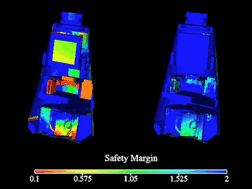FOR IMMEDIATE RELEASE
April 8, 2002
Sandia’s DAKOTA Toolkit on Web and available for free
|

DAKOTA optimizes models of systems using Sandia software such as PRONTO3D and SALINAS. A comparison of safety margin contours for an initial electronics package design. (left) and the optimized design (right) is shown. The initial design violated allowable response levels by a factor of two, whereas the optimized design removed all violations and still met strict weight targets.
Download 300dpi JPEG image, ‘Dakota1.jpg’, 112K (Media are welcome to download/publish this image with related news stories.)
|
ALBUQUERQUE, N.M. — Designers and analysts often ask themselves questions such as: “What is the best design?” “How safe is my design?” “How much confidence do I have in my answer?” A software toolkit developed by the Department of Energy’s Sandia National Laboratories can help answer these questions and assist engineers in designing anything from components to sophisticated systems.
The toolkit, DAKOTA version 3.0, is now available on the Web and can be downloaded for free.
DOE recently granted DAKOTA 3.0 (Design Analysis Kit for Optimization and Terascale Applications) an open-source release under a GNU General Public License. This means any company engineer or university researcher will be able to download DAKOTA and use it to improve their product design or impact their research.

The illustration shows candidate reinforcement concepts for a radar load spreader. DAKOTA optimized each of these designs, allowing for rational comparison and informed selection.
Download 300dpi JPEG image, ‘DAKOTAthree.jpg’, 228K (Media are welcome to download/publish this image with related news stories.)
|
|
Written in the C++ computer language, DAKOTA provides a flexible interface between the designer’s simulation software and the latest algorithms for optimization, uncertainty quantification, parameter estimation, design of experiments and sensitivity analysis. Interfaces between DAKOTA and user-simulation codes can be developed rapidly. To date, more than 20 simulator programs have been interfaced with the software.
Mike Eldred, principal investigator, says that DAKOTA allows designers to develop virtual prototypes of products that can be modified within the computer to minimize weight, cost, or defects; limit critical temperature, stress, vibration, or other responses; or maximize performance, reliability, agility, and robustness. The result: better designs and reduced dependence on prototypes and testing, which shortens design cycles and lowers development costs.
Sandia researchers have been developing DAKOTA for about eight years. The initial work focused on optimization methods, but has since branched out into uncertainty quantification and other areas. It has been used internally at Sandia and externally by researchers at Los Alamos and Lawrence Livermore national laboratories in conjunction with DOE’s Accelerated Strategic Computing Initiative (ASCI) program.
In addition, 15 industrial companies and universities have been granted DAKOTA licenses under the old licensing system.
Now this sophisticated and flexible engineering software is being made available free to virtually anyone who wants it without the hassles of custom licenses.
“Some commercial products exist that allow users to do optimization, but there are a variety of features that make DAKOTA unique — like having the ability to use thousands of processors on a massively parallel computer,” Eldred says.
Other unique features include support for surrogate-based optimization, optimization under uncertainty, mixed integer nonlinear programming, and simultaneous analysis and design, all of which are useful tools for real-world engineering applications.
There are several reasons for making DAKOTA readily available. It will encourage collaborations between Sandia, universities, and other research organizations. This will help infuse the latest research in optimization and related areas into DAKOTA.
Also, the public release will give the software more exposure and use. That is beneficial because as more people use the software, they will contribute enhancements that can be shared with the user community. This expanded use could extend to commercial software companies as well, as several software vendors have expressed interest in using DAKOTA services along with their proprietary software systems.
“The only restriction is that people cannot take the DAKOTA software, change it, and then sell it,” Eldred says. “They can, however, design products with DAKOTA and sell their products.”
The expected positive result will be an improved software toolkit that will be even more efficient and capable for supporting Sandia’s mission.
DAKOTA is a flexible software toolkit that can be used both on massively parallel computing platforms that have thousands to tens of thousands of processors and on a single workstation or a network of workstations. It has been successfully ported to most common UNIX-based workstations including Sun, SGI, DEC, IBM, and LINUX-based PCs.
Technical manuals have been prepared to help walk DAKOTA users through the software. Also, the DAKOTA team has given a number of tutorial workshops and expects to do more in the future. Many engineers and researchers around the country have already served as beta testers for the open source release. These “friendly customers” were given first access to the software and have helped work out any kinks in the new process.
“Now that we’re comfortable with the new process,” Eldred says, “we’re ready to let more people know about it and open it up to the general public.”
Download information is available from http://endo.sandia.gov/DAKOTA, and the DAKOTA team can be contacted via dakota@sandia.gov.
Sandia is a multiprogram laboratory operated by Sandia Corporation, a Lockheed Martin Company, for the United States Department of Energy under contract DE-AC04-94AL85000. With main facilities in Albuquerque, N.M., and Livermore, Calif., Sandia has major research and development responsibilities in national security, energy and environmental technologies, and economic competitiveness.
Sandia Media Relations Contact: Chris Burroughs, coburro@sandia.gov, (505) 844-0948
Sandia Technical contact: Mike Eldred, mseldre@sandia.gov , (505) 844-6479
|
